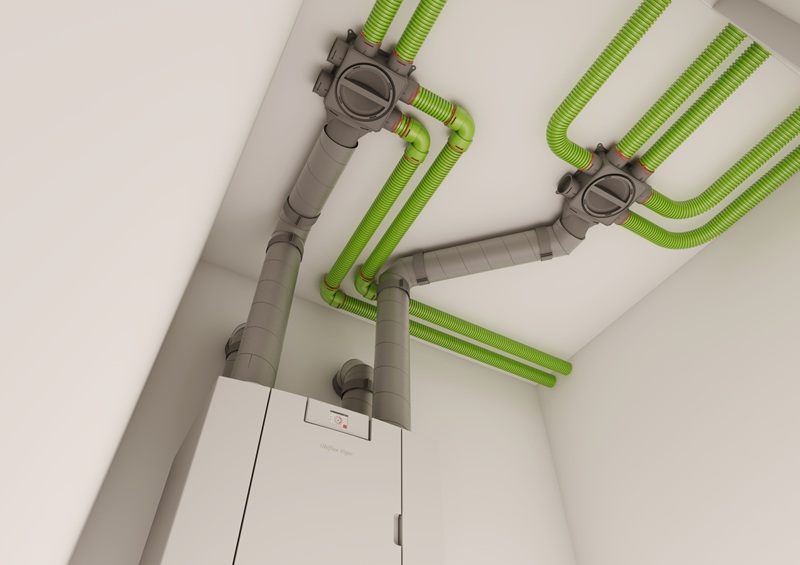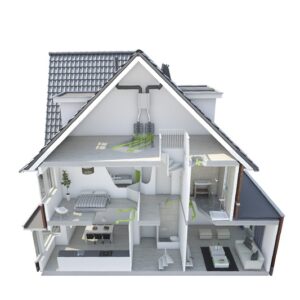
Craig Cundey, Ventilation Lead, Ubbink UK explains how ventilation can help meet the Future Homes and Buildings Standard
The Future Homes and Buildings Standard has been developed to ensure that new homes are ‘future-proofed with low-carbon heating and high levels of energy efficiency’. The Standard has driven changes to UK building regulations that will lead to new homes built from 2025 being expected to achieve net-zero carbon emissions once the electricity grid is decarbonized.
Much has therefore been written in recent years about the need for low-carbon heating in the UK, resulting in growing consumer awareness of solar PV, air- and ground-source heat pumps and other technologies. However, the requirements for improved energy efficiency through effective insulation and airtightness are perhaps less understood.
Effective insulation – and the role of airtightness
The Future Homes and Buildings Standard sets out new minimum standards for insulation (measured in U-values) for the various parts of the building fabric. To achieve these, the Standard also demands higher levels of airtightness. However, whilst beneficial to energy efficiency, airtightness creates other less desirable challenges to building designers.
Poor ventilation can lead to health conditions like asthma, fatigue and even cardiovascular problems. Increased humidity levels in poorly ventilated homes can also lead to condensation and mould forming, creating further potential health issues, as well as contributing to structural problems over time. So, in addition to demanding greater levels of airtightness, the new Standard also demands the need for better ventilation, as covered under Part F of the Building Regulations.
How to gain compliance
As part of the changes to Part L, the required airtightness of dwellings is driving MVHR to becoming the choice for millions of homeowners, as this is the only solution to offer a balanced supply and extract ventilation system. MVHR units monitor not only the moisture in the air but also other levels of pollutants that could go unnoticed – for example C02. MVHR units work in tandem with the occupants and the fabric of the building, maintaining a clean healthy environment and resulting in a damp- and mould-free home with the added benefit of helping the homeowner reduce energy demands.
The Future Homes Standard recognises MVHR as the preferred choice and, although there are other options that you can choose, MVHR is the only solution to offer a healthy, clean environment and which supports Parts L and F in meeting the legal undertakings.

Specification and system design
Designed to run continuously all year round, MVHR is a balanced centralised, whole-house system which delivers fresh filtered air throughout the home. The MVHR unit extracts warm, moist, odour laden air and heat from wet rooms (usually kitchens and bathrooms). This outgoing warm air is introduced to the incoming cold air. As they meet, the temperature of the incoming air is raised as it absorbs the heat. The moisture and odours are not absorbed: they are extracted to the atmosphere. The supplied air is now warm, filtered and free from pollutants providing a healthy environment and also helps reduce the heating demand.
Ubbink MVHR systems offer the additional benefit of retaining up to 92% of the heat from outgoing stale air, re-using it to minimise the energy required to generate new heat.
The performance of any MVHR installation is wholly dependent on its appropriateness to the property in which it’s fitted. The experienced team here at Ubbink UK always ensure all the right points are covered – to provide a design that fits the home – and the lifestyle of the occupants.

First, we will match our unit to suit the property size, with a unique duct design, layout and required airflow rates. Our wide range includes both horizontal and vertical units, allowing discreet installation in ceiling voids, utility rooms, plant rooms or loft spaces. A common mistake is the under-sizing of MVHR units. If the unit is too small for the property it will run at a higher speed to meet the airflow demands. This will cause noise implications and the knock-on effect is an unhappy customer.
Our designers will create an optimised system of ductwork runs, using ducting that is correct for the location within the property. Our ductwork is rated highly within the market providing minimal air resistance and superior air tightness.
We pride ourselves by supporting the UK ventilation market with a ‘Total MVHR’ solution, encompassing everything from consultation and system design to product manufacture, installation and commissioning.
You can find out more about Ubbink Total MVHR solutions here







